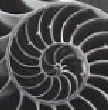
Problems for
Intermediate Methods in Theoretical Physics
Edward F. Redish
 |
Problems for Edward F. Redish |
| Consider two masses connected to each other and to two rigid walls by three identical springs. We make the following approximations:
|
 |
(a) For an arbitrary pair of displacements y1 and y2 find the net forces acting on each of the masses and write Newton's second law for each mass.
(b) Assume both displacements remain very small compared to L so that terms of the the order of (y/L)2 can be ignored compared to first order terms. Show that the equations of motion reduce to equations very similar to the ones we derived for longitudinally moving masses but with an effective k. Express keffective in terms of the parameters of the problem: T, m, l0, and L.
(c) Without solving the problem mathematically, describe what you think the normal modes will look like and what their frequencies might be.
Solution
| (a) For mass 1, assuming that there is no x-displacement, the length of the left spring is
|
 |
and the angle it makes below the vertical is

Therefore, the force produced by the left spring on mass 1 is

Note that

The length of the center spring (also pulling down on mass 1) is

and the angle it makes below the vertical is

Therefore, the force produced by the center spring on mass 1 is

where the sin and cos are given by

We can therefore get N2 for mass 1 to be:

A similar tedious exercise yields the results for mass 2:

where φL and φR are the angles the forces from the center and right springs make above and below the horizontal on mass 2 (pulling it left and right respectively).
(b) If we ignore corrections of the order of the angles to the horizontal squared, then we are ignoring corrections of the order of any (y/L)2. This means that we are approximating

This yields the equations for mass 1 as being the same as those we had before but with a keff.

A similar thing happens for mass 2.
(c) With the masses equal, the modes should be just as we had before: either both moving up and down together with frequency ω02 = keff/m; or both moving in opposite directions with frequency ω02 = 3keff/m.
| University of Maryland | Physics Department | Physics 374 Home |
|---|---|---|
 |
 |
 |
Last revision 15. November, 2005.